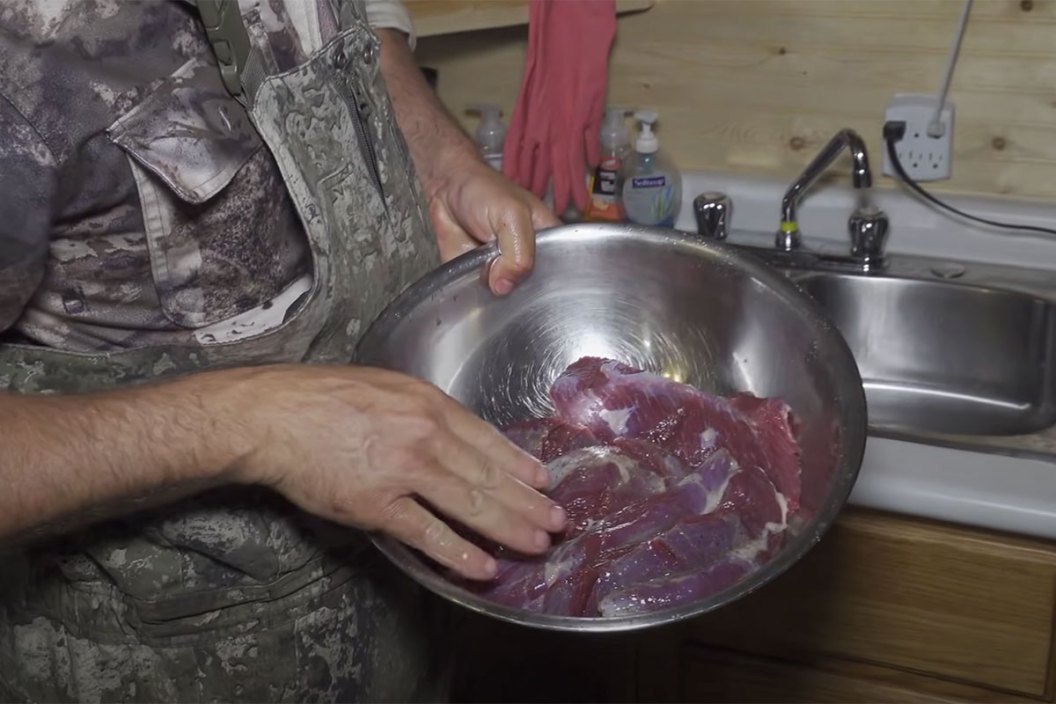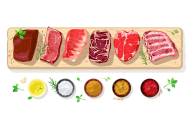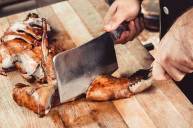Before you go on your next bear hunt, you should know what you're going to do with the meat.
Before you sear it in oil, then toss it in a slow cooker with onion, carrots, celery, beef broth and red wine, you need to take serious consideration for the method used to cook and eat bear meat.
Sure, many of us have already gone down this wild game meat road, but we want the other good folks to know how important bears are to target, hunt, and eat.
Bear meat has an underserved reputation for being tough and greasy, but many wild game chefs will tell you that's just because people aren't preparing or cooking it right.
As omnivores, bears will oftentimes carry the larvae of a nasty parasite, Trichina spiralis. Eating undercooked bear meat can cause trichinosis, which in turn can cause severe sickness or even death in humans. The bottom line is that when cared for and prepared in the proper way, bear meat can be great table fare, but there is risk involved.
Being that we are hopelessly enamored of everything venison when it comes to wild game meat, we need to open our minds a little and grudgingly admit to how many other good game animals there are for cooking and eating. Many people will tell you that bear is one of them.
But is there a difference between the bear species?
Grizzly Bear vs. Black Bear Meat
No matter what wild game we attempt to kill and eat, it comes downs to several factors. After all, any wild game meat can fail an objective taste test, and a meat's flavor and texture can vary by the animal's age, time of year, fat content, and care taken in the field after the kill. Bears are no different.
Valerius Geist, a Canadian zoologist and retired professor at the University of Calgary told MeatEater, "Meat from black bears is widely acclaimed through history, as are bear species that feed almost exclusively on vegetation." Geist even said that Neanderthals ate cave bears because, "cave bears were vegetarians, and feasted on dense root beds growing in deep loess silts flowing and blowing in from nearby massive glaciers."
The difference comes from bears like brown bears—the grizzly's coastal relatives—since they consume mostly fish and carrion they find washed up onshore. Inland grizzlies as well as black bears eat a more balanced diet of roots, grasses, berries, even high-protein insects like moths. That makes their meat quite edible, compared to their dead salmon-eating coastal cousins.
If black bear meat really is the versatile meat some say it is, and works great for roasts, sticks, sausage, and pulled recipes, then it should be the same for grizzly bears. In some Scandinavian countries like Finland, restaurants offer up bear meat as a standard foodstuff for the ordinary, everyday consumer, although some remain skeptical due to a bear's propensity to carry the Trichinella roundworm.
Cooking Bear Meat
Keeping in mind that any bear meat that you eat will be wild, they're all susceptible to carrying one or more of the aforementioned parasites. With that in mind it should be a simple matter to use your meat thermometer and cook it to an internal temperature of 165 degrees. That's what's recommended by the experts to take care of possible parasites, and there's no sense in toying with it.
But at the same time, we all know the old saying: the secret to good table fare doesn't start in the kitchen, but in the field.
Beyond the obvious need to give a big game animal time to expire, getting to it in a timely manner and field dressing it promptly aren't just the only factors when it comes to bears. Many bear hunters will tell you that as soon as possible, skinning the bear helps immensely. It may not be a universal thing, but for some hunters, removing as much of the bear fat as possible, especially while in the field, has a positive effect on the meat as well.
Now, the matter of bear fat is a whole other story, and we won't get into it. Just know that when we suggested removing it, that doesn't mean you have to get rid of it.
Bear meat meal prep is where the good old slow cooker comes to the forefront. Chili, stew, meat to shred for tacos or tamales, and especially roasts are tailor made for bear meat. Sitting in a crockpot for eight or nine hours at a temperature of around 200 degrees will allay most fears of getting sick from any parasitical encounters, and will tenderize your bear with a flavor like no other.
The dream of treating bear meat like a fine beef fillet or venison steak, and producing a similar cut, is one you'll need to get over. You're just not going to have a nice, juicy, medium-rare sous vide bear steak for dinner, so you will have to live with it.
Ground bear meat for burgers or other dishes can work well too, as long as you cook it long enough and double check the temperature.
Here's a smart way to brine it, brought to us by the Stuck N The Rut team of YouTubers, and then grill it up. And of course, they address the question...
What Does Bear Meat Taste Like?
And it's well worth it to watch this entire video with Robert from deermeatfordinner, because he always goes out of his way to show the full story from field to table.
The Bear Meat Bottom Line
No matter where you get your bear in North America, be it Alaska, Colorado, or Wyoming for that matter, you can braise it, BBQ it, make a bear roast, or you can grill it over high heat. Any way you do it, it still needs to be respected. Every hunter and bear meat eater should know that it needs to be cooked to a safe temperature of 165 degree Fahrenheit so that it will kill the parasites sometimes found in them.
With all of the available bear meat recipes, we're simply hoping that some hunters who may have had a little trepidation towards undertaking a bear hunting trip will see that it can be done without all the worry. Don't sweat over what you may or may not do with the meat. Just cook it long enough and enjoy it!
There's just a handful of states that still allow bear hunting to take place without regulations stating that the meat must be salvaged. To us, and to any true outdoorsman, that's a shame. You shouldn't have to be told to use as much of the animal as you can, but requiring it can make a difference in people's feelings. All we're saying is that harvesting wild animals is a meaningful thing, and we shouldn't take any waste lightly.
Additionally, of all game meats you could ever waste, bear is one that brings as much value to your freezer as any other game species. There are so many ways to prepare it for anyone and everyone, regardless if they've ever tried game meat. It's all about taking the proper steps and following a disciplined routine.
There's a reason there are so many devoted bear hunters out there who fill their freezer with their harvests each year. If you try and follow these recipes, you'll quickly learn just how good bear meat can be, but you won't know until you try!
With both spring and fall bear hunting seasons in most areas that allow bear hunts, hunters have two chances per year to bag a bruin and take advantage of a bear meat cookout. For those who may not butcher their own meat, talk to your wild game or deer processor and ask them if they would be willing to butcher a bear.
Chances are that they are not only willing, but perfectly able to do the job safely. Any way you do it, try to put some nutritious and delicious bear meat into your freezer, and you'll thank yourself come dinner time.
Looking for a little more or even hot lunch for your hunting blind? Follow my webpage, or on Facebook, Twitter, and YouTube.
NEXT: HOW TO TREAT WILD GAME MEAT: LESSONS LEARNED FROM A HUNTING FATHER




